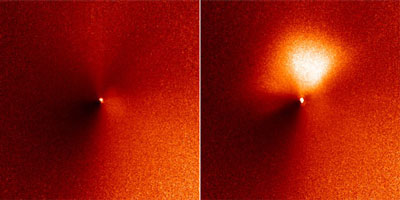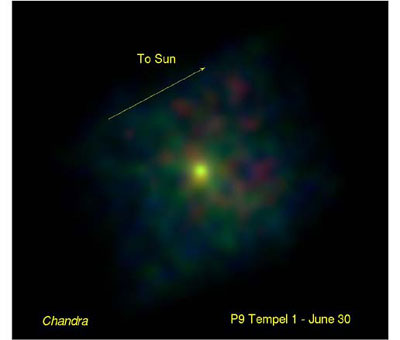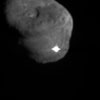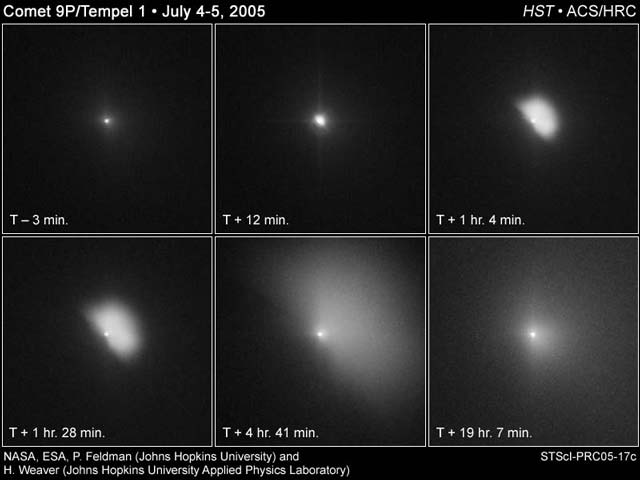|
9P/Temple 1Comet
The comet was
discovery
by Ernst Tempel of Marseille, France on April 3, 1867. The comet orbits the
Sun every 5.5 years in an elliptical orbit between Mars and Jupiter. The
comet has a mass of about 140 billion metric tons and is a potato-shaped object
that is about
3 kilometers in diameter and over 7.6 kilometers long. On June 30, 2005, the
comet's coma was over 60,000 kilometers in diameter. Based upon
50 metric tons of solar dust particle falling on Earth every day, about
1,000 tons of solar dust particles are impact the comet's coma every day or
2 billion kilograms for each orbit around the Sun, which agrees with current
estimates.
After studying antimatter for over 70 years, comets
were discovered to be composed of antimatter. The
announcement was made at April 2002
joint meeting of
American
Physical Society and
American
Astronomical Society. When
sungrazer comets collided with the Sun, they produce enormous explosions
that have damaged communication satellites and disrupted electrical power on
Earth. Antimatter comets are also colliding with stars throughout the Universe and
are the source of
gamma-ray bursts that scientists have been studying for forty years.
Antimatter
is a mirror image of matter; and like matter
can be solid, liquid, gas or
plasma. When matter & antimatter
come together, energy is created according to Einstein's equation or E = mc2:
The most efficient energy source in the Universe.
In 1996, Mike A'Hearn,
University of Maryland, proposed colliding a spacecraft
traveling at 38 kilometers per second into a comet. NASA
rejected his proposal. Two years late, he proposed colliding a
spacecraft into the 9P/Tempel 1 comet, which NASA accepted. NASA's $333
million Deep
Impact Program�s mission was to learn more about the structure and
composition of the comet by making a crater in the comet as
shown below. The crater was estimated to range from 10 meter to a football stadium (about 200 meters in
diameter) and 30 to 50 meters deep as shown in the
computer simulations below.
About 75 percent of the material would fall back onto the
comet; and the remaining 25 percent would be blow off the comet.
|
 |
 |
Computer Simulations |
The Kinetic Energy
from the
spacecraft's collision with the comet would caused a 19 Giga-Joule explosion
what would create the crater and eject material
in a cone at an angle of around 45 to 50 degrees as show above. If the comet
were composed of antimatter, the
worst-case scenario would be
an explosion equivalent to 16,000-Megaton of TNT and shatter the 140 billion
metric ton antimatter comet into trillions of pieces. NASA evaluated their
alternatives;
and on
January 12, 2005, NASA
launched the spacecraft and began tracking its progress.
The
comet produced a spectrum of radiation including light from the interactions
of matter and antimatter.
Solar dust particles
blasted antimatter off the comet's nucleus into space to create the comet's
coma. The coma is a plasma
of ionized matter and
antimatter dust particles and ions, which surround the nucleus as shown
below. The solar wind pulled the plasma off the coma into the comet's tails,
which bend in the direction of the solar wind.
|
 |
Between May 29-31, 2005, the Deep Impact spacecraft took
the
pictures of the comet on the left.
The comet had a well-formed coma with a detectable point source, which
was the comet's nucleus. The comet's coma
was about 60,000 kilometers in diameter and is composed of
ionized solar and comet dust particles and ions.
The brightness of the comet's nucleus was determined to be close
to estimates that were predicted from earlier observations by the Hubble
and Spitzer space telescopes. The spacecraft used the light from matter
and antimatter interactions to target the comet.
|
In an unplanned dress rehearsal for the
rendezvous, the Hubble Space Telescope captured the following dramatic
images of a jet of dust streaming from the antimatter 9P/Tempel 1 Comet.
|

Hi-Res JPEG
(948KB) |
On June 14, 2005, the
images
below
show the
dynamic and volatile of what happens when a small asteroid collided with an
antimatter comet. The bright dot was the light coming from the comet's
nucleus. The two images were taken
seven hours apart and show the comet and the
large jet [bright fan-shaped area] pointing in the direction of the Sun. The ambi-plasma jet extended over 2,200 kilometers into the comet's coma. The
distance is roughly half the distance across the U.S. |
On June 23 and 24, 2005,
another small asteroid collided with comet as
shown in the
pictures
below.
The average image of the comet has been subtracted from each picture to
provide an enhanced view of the outburst. This processing enables measurement of the
outflow speed and the details of the dissipation of the outburst. The left
image was taken when the comet was very close to its normal.

| On June 30, 2005, the Chandra
X-ray Observatory observed the Tempel 1 comet. The false-color
image
shows X-rays coming from the comet, which was caused by matter from
solar dust particles annihilation antimatter from the comet. Chandra
Observatory plans to observe the comet for 18 hours during the time when
NASA's Deep Impact Impactor collides with comet.
The hotlinks and pictures from the
collision will be added when they become available. Ejected
material from the crater is expected to cause
X-ray emissions that will move toward the Sun as shown in the pictures
above.. |
 |
According to
Mike A'Hearn's
article published in the September 8, 2005, issue of Sciencexpress, NASA
recorded three explosions when the
Impactor spacecraft collided with the 9P/Tempel 1 Comet at 10.2
kilometers per second. The first explosion was less than 200
milliseconds. The
second explosion vaporized the
spacecraft, pulverized thousand of tons of material, and blasted hundreds of tons
of dust particles off the comet into its coma. The third explosion was
downrange from the second explosion and appeared to be from Impactor's
propulsion system.
 |
 |
|
The first picture shows the
approximate size of the crater NASA expected to see, which was a hundred
meter in diameter crater.
The
next pictures show the
flash, plume and ejection of the dust particles into space that are
consistent with a
several megaton of TNT explosion.
The energy from
the second
explosion was so large that it saturated the spacecraft's
detectors.
|
The
Hubble Space Telescope
captured the explosion. Tons of
antimatter blasted into the comet's coma interacted with the vaporized Impactor spacecraft
and tons of solar dust particles.
|
 |
For comparison purposes, the
colored picture of the second explosion above was taken by NASA's Deep
Impact flyby spacecraft at about the same time as the
picture in the upper left hand corner by the Hubble Space
Telescope.
The hundreds of tons of antimatter that
were blasted off the comet were scatter over 3,200 kilometer into the
comet's coma. The antimatter dust particles interacted with the hundreds
of tons of solar dust particles that were impacting the comet's coma
every day.
The explosion or explosions continued for over
two days and produced
over a billion times more energy than scientists had estimated.
|
The Mirror Energy was
produced when
matter and antimatter were brought together. Mirror Energy from the
Deep Impact spacecraft was equivalent to 67 billion Giga-Joules. The total
Mirror Energy
produced from the "conversion" of matter and antimatter was estimated to be equivalent to all the energy that the
entire World will be using for the next hundred years.
The
collision between NASA�s Impactor spacecraft and 9P/Tempel 1 Comet
confirms that comets are composed of antimatter: The greatest discovery since
mankind discovered fire thousands of years ago. Since matter and antimatter
explosions are classified a Mirror Energy explosions rather than nuclear
explosions, the United States didn�t violated the
Nuclear Test Ban Treaty of 1963.
Nuclear
explosions are classified as "fission" and "fusion" reactions.
| |